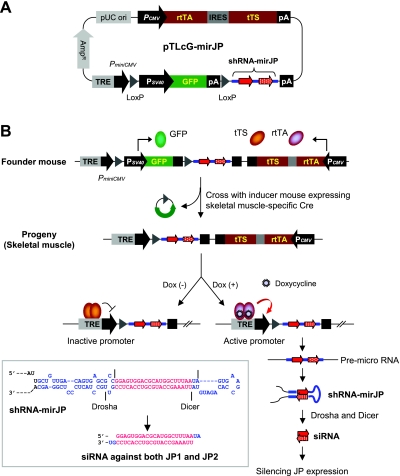Figure 2.
Single-plasmid-based system for inducible and tissue-specific control of gene silencing in transgenic mice. A) Schematic diagrams of pTLcG-mirJP system. Minimal CMV promoter PminiCMV is linked to a TRE, a specific binding site for Tet-responsible transcription factors tTS and rtTA, which are expressed constitutively by a separate SV40 promoter. An internal ribosomal entry site (IRES) sequence permits translation of the 2 open reading frames for tTS and rtTA from single mRNA. A sequence of shRNA-mirJP targeting both JP1 and JP2 mRNAs is located downstream of an internal GFP expression cassette, which is flanked by 2 unidirectional loxP sites. B) Schematic of the experimental strategy in transgenic mice. First, the transgenic founder mice constitutively express tTS, rtTA, and GFP but will not express shRNA-mirJP in any cell. Transgenic offspring mice carrying both pTLcG-mirJP and muscle-specific Cre recombinase produce a functional Tet-on system for shRNA expression due to excision of GFP expression cassette by Cre-mediated recombination in a muscle-specific manner. Without Dox, the tTS molecules bind TRE and actively silence the transcription of the downstream shRNA-mirJP. In the presence of Dox, the shRNA-mirJP can be expressed actively by rtTA and processed by Drosha and Dicer to produce siRNA against JP1 and JP2 mRNA (inset).

